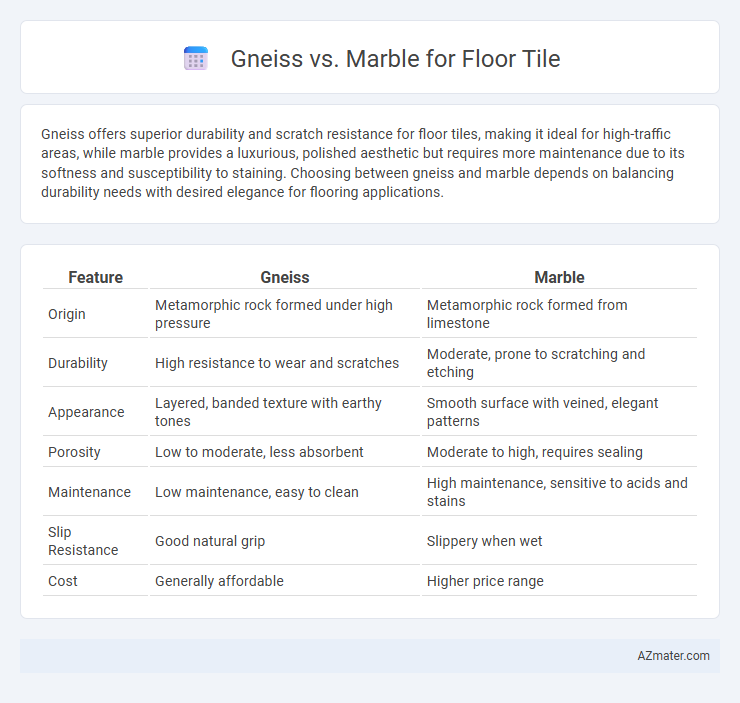Gneiss offers superior durability and scratch resistance for floor tiles, making it ideal for high-traffic areas, while marble provides a luxurious, polished aesthetic but requires more maintenance due to its softness and susceptibility to staining. Choosing between gneiss and marble depends on balancing durability needs with desired elegance for flooring applications.
Table of Comparison
| Feature | Gneiss | Marble |
|---|---|---|
| Origin | Metamorphic rock formed under high pressure | Metamorphic rock formed from limestone |
| Durability | High resistance to wear and scratches | Moderate, prone to scratching and etching |
| Appearance | Layered, banded texture with earthy tones | Smooth surface with veined, elegant patterns |
| Porosity | Low to moderate, less absorbent | Moderate to high, requires sealing |
| Maintenance | Low maintenance, easy to clean | High maintenance, sensitive to acids and stains |
| Slip Resistance | Good natural grip | Slippery when wet |
| Cost | Generally affordable | Higher price range |
Introduction: Gneiss vs Marble Floor Tiles
Gneiss floor tiles offer high durability and unique banded patterns created by the metamorphic process, making them ideal for high-traffic areas. Marble floor tiles provide a classic, elegant appearance with smooth veining and a polished surface, preferred for luxurious interior designs. Both materials differ significantly in hardness, porosity, and maintenance requirements, influencing their suitability for various flooring applications.
Geological Origins and Formation
Gneiss is a metamorphic rock formed through high-grade regional metamorphism of igneous or sedimentary rocks, characterized by its distinct banded texture resulting from intense heat and pressure deep within the Earth's crust. Marble originates from the metamorphism of limestone or dolomite, undergoing recrystallization under moderate to high temperature and pressure that produces its smooth, crystalline surface and often vibrant veining. Both materials offer durable floor tile options, but their geological origins influence their texture, hardness, and resistance to wear.
Visual Appearance and Aesthetic Appeal
Gneiss floor tiles showcase a distinctive banded or foliated texture with a mix of earthy tones, providing a natural, rugged aesthetic ideal for rustic or contemporary interiors. Marble tiles offer a smooth, polished surface with elegant veining patterns in a range of light to dark hues, imparting a luxurious and timeless appeal perfect for sophisticated spaces. The choice between gneiss and marble influences the visual warmth and texture of flooring, impacting overall interior ambiance and design style.
Durability and Hardness Comparison
Gneiss floor tiles exhibit superior durability and hardness due to their tightly interlocked mineral grains, making them highly resistant to scratches, chipping, and wear compared to marble. Marble, composed primarily of calcite, is softer and more prone to etching and surface damage from acidic substances, requiring more frequent maintenance. The robust composition of gneiss makes it ideal for high-traffic areas, while marble suits low-traffic spaces where aesthetic appeal is prioritized over hardness.
Water and Stain Resistance
Gneiss offers superior water resistance compared to marble due to its dense, non-porous structure, making it ideal for high-moisture areas such as bathrooms and kitchens. Marble is more porous and prone to staining, requiring regular sealing and maintenance to protect against water damage and discoloration. For flooring, gneiss provides enhanced durability and stain resistance, ensuring longer-lasting performance in environments exposed to spills and humidity.
Maintenance and Cleaning Requirements
Gneiss floor tiles offer superior durability and resistance to scratches and stains compared to marble, requiring less frequent sealing and simpler cleaning with mild detergents. Marble tiles demand more careful maintenance due to their porous nature, necessitating regular sealing and prompt cleaning to prevent etching and discoloration from acidic substances. Both materials benefit from routine sweeping and damp mopping, but gneiss's harder surface makes it more suitable for high-traffic areas with lower upkeep.
Cost and Budget Considerations
Gneiss floor tiles typically cost less than marble due to the abundance and ease of quarrying gneiss, making it a budget-friendly option for large-scale projects. Marble, prized for its classic elegance and unique veining, commands a higher price, impacting overall renovation or construction budgets significantly. When choosing between gneiss and marble tiles, assessing the long-term value against upfront costs ensures alignment with financial constraints and design goals.
Installation Process and Challenges
Gneiss floor tiles require precise cutting due to their foliation and directional grain, which can cause uneven edges if not handled carefully, leading to complex installation challenges. Marble tiles, softer and more porous, demand skilled handling and sealing to prevent cracks and stains during and after installation, increasing labor time and maintenance needs. Choosing between gneiss and marble involves balancing gneiss's durability and intricate installation with marble's aesthetic appeal and sensitivity to handling.
Sustainability and Environmental Impact
Gneiss floor tiles offer higher sustainability due to their natural durability and lower processing requirements, resulting in reduced energy consumption and carbon emissions compared to marble. Marble extraction involves intensive quarrying and chemical treatments that contribute to environmental degradation and increased waste. Choosing gneiss supports eco-friendly flooring with a smaller carbon footprint and longer lifecycle benefits.
Best Applications: Residential vs Commercial Uses
Gneiss floor tiles excel in commercial settings due to their durability, resistance to heavy foot traffic, and unique banded patterns that enhance high-traffic areas and office lobbies. Marble tiles, prized for their elegant veining and luxurious appearance, are better suited for residential spaces such as living rooms and bathrooms where aesthetic appeal and moderate foot traffic are priorities. Both materials offer distinct visual and functional benefits, but gneiss's robustness makes it ideal for commercial applications, while marble's refined beauty complements residential interiors.

Infographic: Gneiss vs Marble for Floor tile
 azmater.com
azmater.com